Results
-
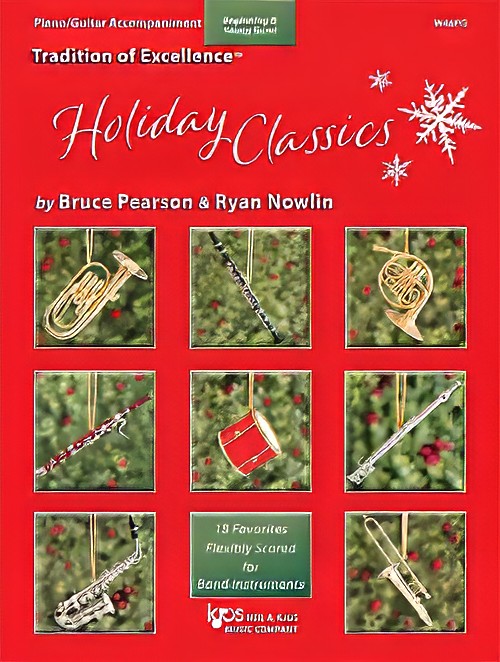 £8.99
£8.99Holiday Classics (Piano/Guitar Accompaniment) - Nowlin & Pearson
Welcome to Tradition of Excellence: Holiday Classics, a collection of eighteen holiday songs all arranged for maximum performance flexibility.Features:Scored for maximum performance flexibility.Mix-and-match any combination of band instruments.Playable as solos, duets, trios, larger ensembles, or even full concert band.Add the Piano/Guitar Accompaniment to enhance performance.Drums, Mallets, Auxiliary Percussion, and Timpani all in one book to develop the total percussionist.Discover 18 favourite holiday melodies:Jingle BellsUp on the HousetopThe Dreidel SongJolly Old St NicholasWe Wish You a Merry ChristmasChanukah, Oh ChanukhaWe Three KingsO Come, O Come EmmanuelAdeste Fidelis (O Come All Ye Faithful)Ding Dong Merrily on HighDeck the HallsJoy to the WorldThe First NoelGod Rest You Merry, GentlemenHark! The Herald Angels SingGo Tell It on the MountainAngels We Have Heard on HighAuld Lang Syne
Estimated dispatch 7-14 working days
-
 £92.00
£92.00Jeux Interdits (Guitar Solo)
Estimated dispatch 7-14 working days
-
 £124.10
£124.10 -
 £136.00
£136.00Concerto for Guitar and Band - Juan A. Perez
Estimated dispatch 7-14 working days
-
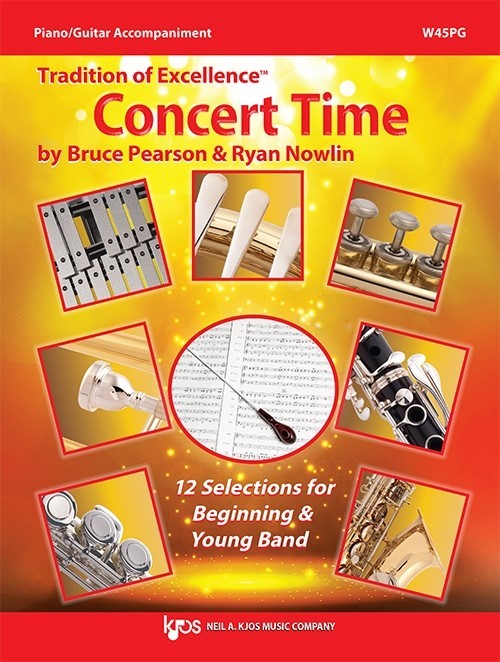 £7.99
£7.99Concert Time (Piano/Guitar Accompaniment) - Nowlin & Pearson
Concert Time, by Bruce Pearson and Ryan Nowlin, is a collection of twelve songs written for beginning or young band. An excellent compilation and variety of music styles, Concert Time includes festival pieces, concert marches, classical transcriptions, lively lighter songs, and originals. With accessible, grade-appropriate rhythms, highlights also include clarinets staying below the break in each song, melodies are written in every section, and the Drums, Mallets, Auxiliary Percussion, and Timpani are all in one book. With reinforced orchestration throughout the ensemble, each piece was composed or arranged with the young player in mind and will prove to be accessible and musically satisfying to the player and the audience. Each concert time part book includes a Fingering Chart and Preparatory Melodies. Concert Time is part of the Tradition of Excellence series and is an outstanding addition to any band curriculum. Includes: The Holidays are Here; North Winds; A Journey Together; Fire Rock; Home Days; One of These Days; To the Castle; The Earle of Oxford's Marche; On the Carousel; Practice Report Blues; Psalm and Dance; Steadfast Overture.
Estimated dispatch 7-14 working days
-
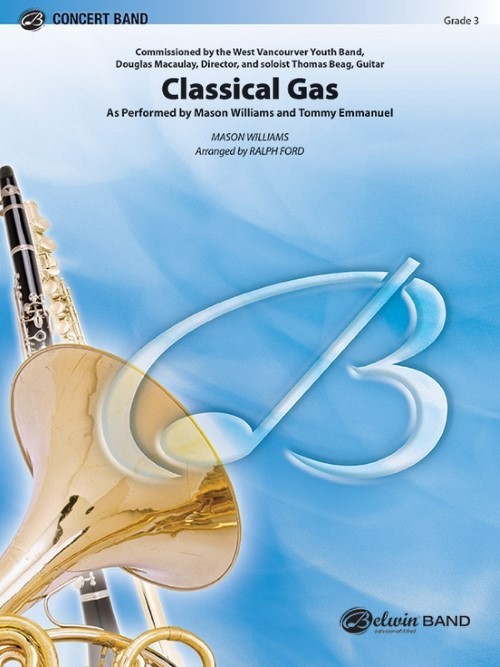 £76.95
£76.95Classical Gas (Mallet or Guitar feature with Concert Band - Score and Parts) - Williams, Mason - Ford, Ralph
Composed and performed by Mason Williams in the late '60s and more recently by Tommy Emmanuel, this classic rock tune is sure to be well received by the performers and audiences alike. Choose to feature your outstanding guitarist or mallet percussionist on the solo with the rousing band accompaniment. There are a variety of solo options at different difficulty levels to make this revered chart accessible to a wide variety of soloists. It's a Gas!Duration: 3:15
Estimated dispatch 7-14 working days
Audio Player -
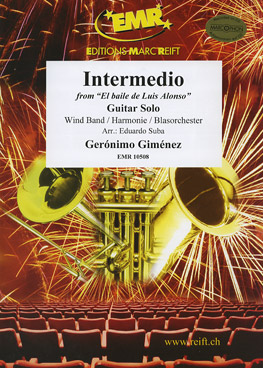 £124.10
£124.10INTERMEDIO (Guitar Solo with Intermediate Concert Band) - Gimenez, Geronimo - Suba, Eduardo
Duration: 4:00
Estimated dispatch 7-14 working days
Audio Player -
 £113.30
£113.30Moderate Dances - Angelo Sormani
This piece is a tribute to dance music, especially passionate, intense and meditative dance music. "Moderate Dances" is divided into three movements: a "Tango", a "Slow Waltz" and a "Bossa Nova". Each movement and each dance has its own particular characteristics but, when combined, these different rhythmic beats and times give the piece a feeling of completeness and uniformity. The Tango started to flourish in the suburbs of Buenos Aires in around 1880. There is still some doubt as to its origins, which may be Cuban (Habanera) but are probably African. It was most popular in Argentina and Brazil: here the male protagonist was originally the "gaucho" with his inseparable guitar, later to be replaced by the proud, elegant "compadre". By around 1910 the Tango had spread to Italy and France. New clubs opened, where the upper classes could watch and dance the Tango. Here the dance also underwent some rapid transformations. The exaggerated and extravagant gestures and body movements disappeared. Slow, gliding steps replaced the old rotational movements. The women's red ankle-boots and the partners "staring into each other's eyes" accentuated the erotic nature and sensuality of this dance. So much so that, in 1913, the German government banned soldiers from dancing the Tango. Those who broke the law were immediately discharged from the army. From a strictly musical perspective, the basic instruments were a flute, a harp (the diatonic harp typically played by the Indians of Paraguay) and a violin, or flute, guitar and violin or even clarinet, guitar and violin. These instruments were easy to transport, ideal for playing at parties, in the streets and in courtyards. The musicians played by ear, frequently improvising: there were no scores, no records, which is the main reason why it is impossible to trace the Tango back to its exact origins. However, the Tango's evolution (and growing popularity) was once again fostered by its fundamental ability to absorb "other" cultures, languages and sounds. And it was the arrival of the "bandoneon" (an accordion-like instrument that was invented in Germany and brought to Rio de la Plata by some immigrant), which replaced the flute, that marked the beginning of the Tango's huge success outside Argentina. A number of talented composers, above all the great Astor Piazzola (1921-1992), transformed the bandoneon from a simple accompanying instrument to a solo instrument that was to become the distinguishing feature of the 20th century Tango. The Slow Waltz originated from the Waltz, the typical dance of the Bavarian and Tyrolese peasants in the 1700s. It was composers like Johann Strauss, father and son, who carried the Waltz to its zenith in the 1800s, creating the sensual and melancholy yet joyful and charming dance we are all familiar with. When the Waltz first became popular in Germany, the members of respectable society were shocked at the closeness of the dancing partners, who had always previously danced apart. The main difference between the Waltz and Slow Waltz is that the latter has a slower, more expressive rhythm: the men wear tails and the women wear ball gowns decorated with beads and feathers and couples dance in graceful rotational movements. "Bossa Nova" is the title of the last movement in the piece. Jobim, the great Brazilian musician, described this musical genre as a combination of modern Jazz and Samba. Bossa Nova means "new wave". This was the name of the artistic and musical movement that evolved in Brazil in the late Fifties and was extremely popular throughout the Sixties. The songs are usually about love or social matters, drawing inspiration from the slums of Rio De Janeiro and the lives of their inhabitants. Bossa Nova, with its original compositions and the artistic talent of its musicians, also became hugely popular in the United States and Europe, and top Jazz musicians (Ella Fitzgerald, Stan Getz, Bob Cooper, Charlie Bird, Sonny Rollins, Dexter Gordon, Dizzy Gillespie) started to include Bossa in their repertoires.
Estimated dispatch 7-14 working days
-
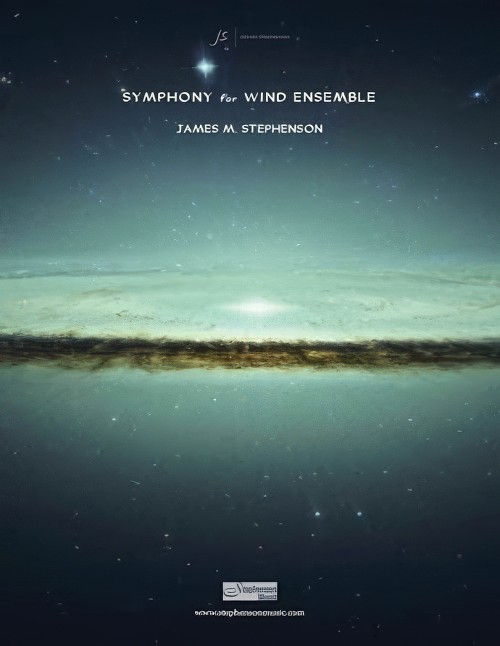 £284.99
£284.99Symphony for Wind Ensemble (Concert Band - Score and Parts) - Stephenson, James M.
The symphony is in four movements. The first movement starts a single triangle note, followed by a guitar strum. The movement anxiously attempts to churn into action, only to be stifled repeatedly by the single triangle note. Finally, with the guitar as inspiration, the main theme gets under way, revealing an almost Spanish, or even Eastern European flavor. Ideas and themes get reworked, developed, repeated and augmented throughout the movement, before finally closing out just as it began, but in reverse: this time guitar followed by triangle. The second movement steals from an angular and shrieking motif of the first, but is presented in opposite fashion: with the warm blend of the low brass. Hints of iconic military symbolism are interspersed throughout this movement, as homage to the commissioning ensemble. The main theme is inverted and awarded to a solo trumpet midway before giving way to a brass fanfare, though not done loudly, but here muted, from afar. The low brass return at the end, fading away to nothing as the bell tolls. The third movement is merely a short interlude - a break, in almost Gershwin-like fashion - from the seriousness of the movements that precede and follow. Lastly, the fourth movement is a wild one: with mixed meters and plentiful percussion penned to propel the movement throughout. The movements' themes are all reworkings of material presented earlier. Duration: 25.00
Estimated dispatch 7-14 working days
-
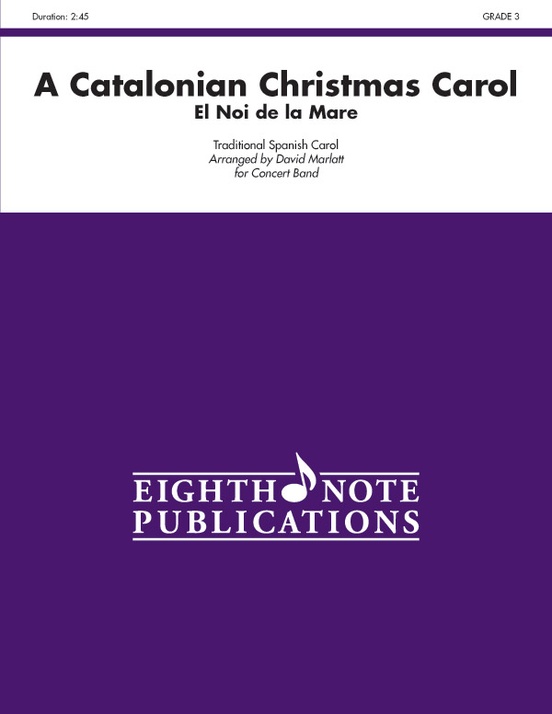 £62.95
£62.95A Catalonian Christmas Carol
This traditional folk song from Catalonia (a region in Spain) has been regularly sung during the Christmas season all over the world. There are also numerous instrumental versions, including notable ones for solo guitar that are very popular. This arrangement begins like the guitar versions---simple, light, and clean. It grows to be more full and sonorous than a guitar ever could, before ending, as it began---peacefully. (2:45)
Estimated dispatch 3-5 working days
Audio Player
